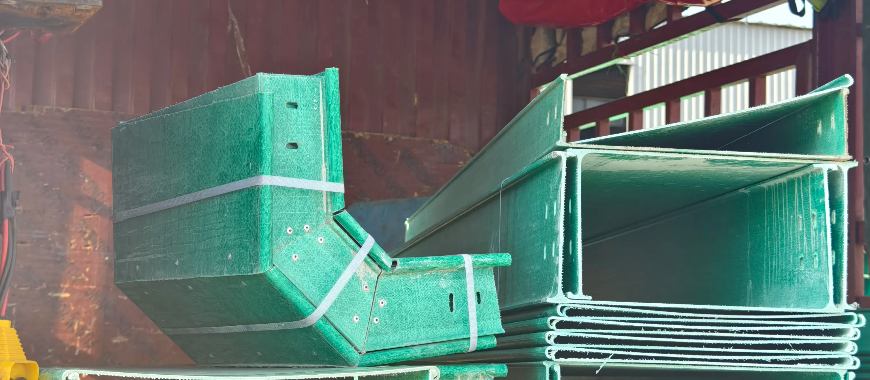
Proper cable tray sizing plays a crucial role in electrical installations, directly impacting the safety, efficiency, and reliability of cable management systems. Whether in commercial buildings or industrial facilities, selecting the right tray ensures that cables are well-supported and protected. In setups where a cable race tray is used, accounting for its design and capacity is essential to prevent overcrowding and maintain proper airflow. Ensuring that cable trays are appropriately sized helps support the load of cables while preventing overheating, congestion, or damage. This blog aims to guide you through the process of calculating the area of a cable tray in inches. Along the way, we’ll discuss important tools, best practices, and compliance with industry standards to ensure your installations meet both functional and regulatory requirements. By the end, you’ll have a clear understanding of how to select the right cable tray size for your specific project needs.
How to Calculate Area of Cable Tray
What is Cable Tray Area?
The cable tray area is defined as the product of the tray’s width and its loading depth. In simple terms, it represents the available space within the cable tray for laying cables. For instance, a cable tray with a width of 12 inches and a loading depth of 4 inches has a total area of 48 square inches (12 × 4 = 48). This measurement is fundamental for determining how many cables can safely be accommodated in a given tray without exceeding capacity.
Best Materials for Cantilever Cable Tray in Projects
Why is Cable Tray Area Important?
Properly calculating the cable tray area is essential for several reasons:
Ensures Compatibility with Cable Volume
Electrical cables come in various sizes, and their total volume must fit within the tray’s area. If the tray is too small, cables may be compressed, leading to insulation damage or difficulty during future maintenance.
Master Cable Tray Calculator Tools for Precise Results
Prevents Overheating
Cables generate heat during operation. Overcrowded trays can restrict airflow, causing heat buildup. This increases the risk of overheating, which can lead to reduced cable lifespan, system inefficiency, or even fire hazards. Calculating the tray area ensures that cables are spaced adequately to dissipate heat effectively.
Complies with Safety Standards
Regulatory bodies, such as the National Electrical Code (NEC) or IEC standards, specify requirements for cable tray sizing to maintain safety and performance. Ensuring the cable tray’s area aligns with these standards helps avoid compliance issues and ensures a safe installation.
By understanding and correctly applying the principles of cable tray area calculation, you can make informed decisions that support both safety and efficiency in your electrical installations. In the following sections, we’ll dive deeper into how to calculate area of cable tray step-by-step, with examples and tips for selecting the right tray size for your project.
Essential Guide to Calculating Cable Tray Area Efficiently
Steps :How to Calculate Area of Cable Tray
Accurately determining the area of a cable tray is a fundamental step in ensuring safe and efficient cable management. Below is a step-by-step guide on how to calculate area of cable tray in inches.
Step 1: Measure Tray Dimensions
The first step in calculating the cable tray area is to measure its physical dimensions:
- Width: Measure the internal width of the cable tray in inches. This is the horizontal space available for laying cables.
- Height (Loading Depth): Measure the internal height or loading depth of the tray in inches. This refers to the vertical space from the bottom of the tray to the maximum allowable height of cable placement.
Example
Consider a cable tray with the following dimensions:
- Width = 12 inches
- Height = 4 inches
Step 2: Apply the Area Formula
Once the dimensions are measured, apply the basic area formula to determine the total available area inside the tray:
Area (A)=Width×Height
This calculation gives the total square inches of usable space in the cable tray.
Example Calculation
Using the tray dimensions measured in Step 1:
A=12in×4in=48in2
This means the cable tray provides 48 square inches of space for cables.
Why These Steps Matter
These simple steps ensure that the cable tray can accommodate the required cables without exceeding capacity. Overloading a tray can lead to issues such as insufficient airflow, overheating, and difficulty maintaining compliance with safety standards. Following these steps carefully ensures a safe and effective design for your electrical system.
In the next section, we’ll explore additional factors, such as allowable fill percentage and examples of real-world applications, to further refine your calculations.
Key Tools :How to Calculate Area of Cable Tray
When working through how to calculate area of cable tray, leveraging the right tools can significantly streamline the process and ensure accuracy. Below are some essential resources that can aid in cable tray sizing calculations.
Excel Sheets for Cable Tray Sizing
Excel spreadsheets are among the most popular tools for performing cable tray calculations due to their flexibility and ease of use.
Features
- Pre-Formulated Calculations: Spreadsheets can include formulas that automatically calculate the tray area once you input the width and height dimensions.
- Customizable Fields: Users can add fields for cable fill percentage, cable types, or specific regulatory limits.
- Error Checking: Alerts can be programmed to warn if the calculated tray area is insufficient for the specified cable volume.
Example Use
- Open a pre-configured Excel sheet designed for cable tray sizing.
- Enter tray dimensions, such as width (e.g., 12 inches) and height (e.g., 4 inches).
- Input additional parameters, like the number and types of cables or desired fill percentage.
- The sheet will automatically calculate the required tray area and compare it against the dimensions entered, ensuring compliance and adequacy.
Excel sheets can also include NEC or IEC-compliant tables, allowing for quick reference to standards.
PDF Guides for Cable Tray Sizing
PDF guides are another valuable resource, especially for those who need a comprehensive reference to industry standards and visual aids.
Features
- Standards-Compliant Information: Many guides are tailored to meet NEC, IEC, or other regulatory standards, providing accurate and reliable information.
- Calculation Examples: These documents often include step-by-step examples, showing how to calculate the tray area and verify compliance with safety and fill guidelines.
- Visual Aids: Most PDF guides include visual tools, such as NEC fill charts, which show the allowable fill percentage for different cable tray sizes and configurations.
Example Use
- Download a PDF guide from a trusted source, such as a cable tray manufacturer or standards organization.
- Refer to the examples provided to calculate the tray area based on your project dimensions.
- Use visual aids like fill charts to ensure that the selected cable tray meets capacity and compliance requirements.
PDF guides are especially useful for professionals who want to cross-check manual calculations or understand the broader context of tray sizing regulations.
Why Use These Tools?
By utilizing Excel sheets and PDF guides, you can:
- Save time by automating repetitive calculations.
- Minimize errors in sizing and compliance.
- Access detailed reference material for ensuring best practices in cable management.
Incorporating these tools into your workflow ensures efficiency and accuracy when determining the appropriate cable tray size for any project.
Cable Tray Fill and Sizing Standards
Understanding cable tray fill and sizing standards is critical when learning how to calculate area of cable tray. Compliance with these standards ensures that the tray is neither overcrowded nor unsafe for operation. Below, we explore key guidelines and tools to achieve proper sizing.
NEC Cable Tray Fill Compliance
The National Electrical Code (NEC) provides clear guidelines on the maximum allowable fill percentage for different types of wiring to ensure safety and functionality.
The 50% Fill Rule for Signal and Control Wiring
For signal and control cables, the NEC specifies a maximum fill of 50% of the tray’s total area. This rule ensures adequate space for airflow, reducing the risk of overheating and allowing for future expansion or maintenance.
Example Application
Consider a cable tray with a total area of 48 square inches (e.g., 12 inches width × 4 inches height). According to the 50% fill rule:
Maximum Fill Area=48in2×50%=24in2
This means the total cross-sectional area of all cables in the tray must not exceed 24 square inches. This calculation provides a safety margin to prevent overloading and overheating.
Cable Tray Fill Chart
A cable tray fill chart is a quick-reference tool that helps professionals estimate the fill percentage based on cable diameter and tray dimensions. These charts are especially useful when dealing with multiple cable types or sizes.
Usage
- Determine the total number and diameter of the cables you plan to use.
- Refer to the chart to find the cross-sectional area occupied by those cables.
- Compare the total cable area to the tray’s available area to ensure compliance with fill percentage limits (e.g., 50% for signal and control cables).
Example Application
Imagine a scenario where you are installing CAT6 cables in a standard cable tray. The diameter of each CAT6 cable is approximately 0.25 inches. If you plan to install 50 cables, the total cable area can be calculated as follows:
- Area of One Cable:
Aone cable=π×(0.25in/2)2=0.049in2
- Total Cable Area:
Atotal=0.049in2×50=2.45in2
- Compare this to the allowable fill area of the tray (e.g., 24 in² for a 48 in² tray with 50% fill). Since 2.45 in² is well below the limit, the configuration is compliant.
Formulas:How to Calculate Area of Cable Tray
When designing or evaluating a cable tray system, it’s crucial to understand how to calculate area of cable tray by using proper sizing formulas. This ensures that the tray can accommodate the required cables while adhering to safety and regulatory standards. Below, we break down the key formulas and provide a practical example to help you apply these concepts.
Key Formula for Round Cables
For round cables, the cross-sectional area is calculated using the formula for the area of a circle:
Area=πr2
Where:
- rr is the radius of the cable (half of the cable’s diameter).
- π\pi is approximately 3.1416.
This formula is critical for determining the space occupied by a single cable, which can then be used to calculate the total area required for multiple cables.
Practical Example: Calculating Aggregate Cable Area
Let’s apply the formula to calculate the total area required for a set of cables in a tray:
Given Data
- Cable Diameter: 0.5 inches
- Number of Cables: 40
Step 1: Calculate the Area of One Cable
To find the cross-sectional area of a single cable:
r=2Diameter=20.5=0.25in
Substitute rr into the formula:
Area of One Cable=πr2=3.1416×(0.25)2=3.1416×0.0625=0.196in2
Step 2: Calculate the Aggregate Area for 40 Cables
Multiply the area of one cable by the total number of cables:
Total Cable Area=40×0.196=7.84in2
This means that all 40 cables will require a total cross-sectional area of 7.84 square inches within the cable tray.
Applying the Calculation to Tray Sizing
Once the total cable area is calculated, compare it to the available area of the cable tray. For instance, if the tray has a total area of 24 square inches (based on its width and height) and a maximum allowable fill of 50%:
Allowable Cable Area=24in2×50%=12in2
FAQS about how to calculate area of cable tray
To calculate the cable tray area, you need to determine the total cross-sectional area required to accommodate all the cables safely. First, find the cross-sectional area of each cable, which is typically provided by the manufacturer. Sum up the areas of all the cables you plan to lay in the tray. Then, apply a fill factor, usually specified by standards such as NEC or IEC, which determines the percentage of the tray that can be occupied by cables (e.g., 40% or 50%). This ensures proper ventilation and reduces the risk of overheating. For instance, if the total cable area is 200 cm² and the fill factor is 50%, you’ll need a cable tray with a minimum area of 400 cm².
To size a cable tray, follow these steps:
Determine the Total Cable Area: Calculate the cross-sectional area of all cables to be laid in the tray and sum them up.
Consider the Fill Factor: Apply the fill factor (e.g., 40%-50%) as specified by local codes or standards to allow proper airflow and future expansions.
Choose the Tray Dimensions: Based on the calculated area, select a tray width and height that provide sufficient space. Manufacturers typically offer standard tray sizes like 6″, 12″, or 24″ widths.
Account for Future Expansion: Consider additional space for future cable installations or upgrades, which might require a tray with a larger capacity than initially calculated.

As the editor of GangLong Fiberglass, I have years of experience and in-depth research, focusing on cable tray products, fiberglass solutions, and grille systems. I incorporate years of industry insights and practical experience into every content, committed to promoting the progress of the industry. At GangLong Fiberglass, my commitment is reflected in every product, from innovative cable trays to durable fiberglass solutions and sturdy grille systems. As an authoritative voice in the industry, my goal is to provide valuable information to professionals and businesses and promote forward-looking solutions.


